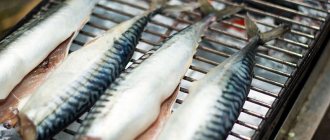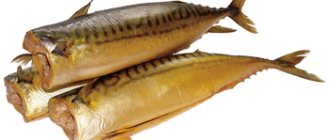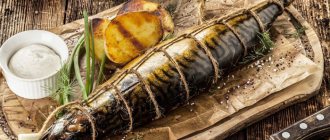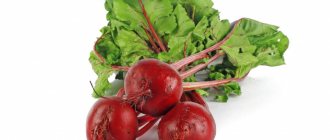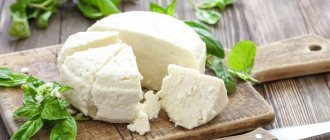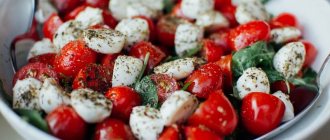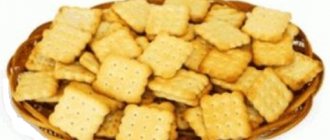Mackerel is a member of the mackerel family. This is a heat-loving, schooling fish that can reach a length of up to 60 centimeters. Mackerel has an elongated body, which is covered with small scales.
As a rule, mackerel gather in schools, and there are no fish of other species in schools. The optimal temperature for fish is from 8 to 20 degrees. During winter, the fish goes to a depth of up to 250 meters, where it leads a sedentary lifestyle, and in the spring it moves closer to the shores. The average lifespan of mackerel reaches 15-18 years.
Delicious mackerel dishes are often found on Russian tables. Both adults and children love her. But what is the nutritional value of mackerel and how high-calorie this fish is, you can find out from this article. And also below will be presented several delicious recipes for preparing this fish.
Chemical composition
The chemical composition of mackerel contains a huge amount of substances vital for the human body. The benefits of this fish are ensured by the fact that it contains the following elements:
- vitamins of group B, A, C;
- selenium;
- calcium;
- sodium;
- magnesium;
- fluorine;
- nickel;
- iodine;
- molybdenum;
- cobalt;
- phosphorus;
- iron;
- potassium;
- zinc;
- copper;
- manganese.
It is important to note that by consuming just 100 grams of this fish during the day, you can ensure that your body is full:
- selenium – 93.8% of the daily value;
- phosphorus – by 39.7% of the daily norm;
- vitamin B12 – 791.7% of the daily requirement.
The nutritional value of 100 grams of mackerel is:
- 18 grams of protein;
- 13.2 grams fat;
- 0 grams of carbohydrates;
- 0 grams of dietary fiber;
- 67.5 grams of water.
Calorie content Salted mackerel. Chemical composition and nutritional value.
Nutritional value and chemical composition of “Salted mackerel”.
The table shows the nutritional content (calories, proteins, fats, carbohydrates, vitamins and minerals) per 100 grams of edible portion.
| Nutrient | Quantity | Norm** | % of the norm in 100 g | % of the norm in 100 kcal | 100% normal |
| Calorie content | 305 kcal | 1684 kcal | 18.1% | 5.9% | 552 g |
| Squirrels | 18.5 g | 76 g | 24.3% | 8% | 411 g |
| Fats | 25.1 g | 56 g | 44.8% | 14.7% | 223 g |
| Water | 43 g | 2273 g | 1.9% | 0.6% | 5286 g |
| Ash | 13.4 g | ~ | |||
| Vitamins | |||||
| Vitamin A, RE | 47 mcg | 900 mcg | 5.2% | 1.7% | 1915 |
| Retinol | 0.047 mg | ~ | |||
| Vitamin B1, thiamine | 0.02 mg | 1.5 mg | 1.3% | 0.4% | 7500 g |
| Vitamin B2, riboflavin | 0.19 mg | 1.8 mg | 10.6% | 3.5% | 947 g |
| Vitamin B4, choline | 101.6 mg | 500 mg | 20.3% | 6.7% | 492 g |
| Vitamin B6, pyridoxine | 0.41 mg | 2 mg | 20.5% | 6.7% | 488 g |
| Vitamin B9, folates | 15 mcg | 400 mcg | 3.8% | 1.2% | 2667 g |
| Vitamin B12, cobalamin | 12 mcg | 3 mcg | 400% | 131.1% | 25 g |
| Vitamin D, calciferol | 25.2 mcg | 10 mcg | 252% | 82.6% | 40 g |
| Vitamin D3, cholecalciferol | 25.2 mcg | ~ | |||
| Vitamin E, alpha tocopherol, TE | 2.38 mg | 15 mg | 15.9% | 5.2% | 630 g |
| Vitamin K, phylloquinone | 7.8 mcg | 120 mcg | 6.5% | 2.1% | 1538 g |
| Vitamin RR, NE | 3.3 mg | 20 mg | 16.5% | 5.4% | 606 g |
| Macronutrients | |||||
| Potassium, K | 520 mg | 2500 mg | 20.8% | 6.8% | 481 g |
| Calcium, Ca | 66 mg | 1000 mg | 6.6% | 2.2% | 1515 g |
| Magnesium, Mg | 60 mg | 400 mg | 15% | 4.9% | 667 g |
| Sodium, Na | 4450 mg | 1300 mg | 342.3% | 112.2% | 29 g |
| Sera, S | 185 mg | 1000 mg | 18.5% | 6.1% | 541 g |
| Phosphorus, P | 254 mg | 800 mg | 31.8% | 10.4% | 315 g |
| Microelements | |||||
| Iron, Fe | 1.4 mg | 18 mg | 7.8% | 2.6% | 1286 g |
| Copper, Cu | 100 mcg | 1000 mcg | 10% | 3.3% | 1000 g |
| Selenium, Se | 73.4 mcg | 55 mcg | 133.5% | 43.8% | 75 g |
| Zinc, Zn | 1.1 mg | 12 mg | 9.2% | 3% | 1091 g |
| Sterols (sterols) | |||||
| Cholesterol | 95 mg | max 300 mg | |||
| Saturated fatty acids | |||||
| Saturated fatty acids | 7.148 g | max 18.7 g | |||
| 12:0 Lauric | 0.029 g | ~ | |||
| 14:0 Miristinovaya | 1.082 g | ~ | |||
| 16:0 Palmitinaya | 4.418 g | ~ | |||
| 18:0 Stearic | 1.403 g | ~ | |||
| Monounsaturated fatty acids | 8.32 g | min 16.8 g | 49.5% | 16.2% | |
| 16:1 Palmitoleic | 1.495 g | ~ | |||
| 18:1 Oleic (omega-9) | 4.224 g | ~ | |||
| 20:1 Gadoleic (omega-9) | 1.034 g | ~ | |||
| 22:1 Erucic (omega-9) | 1.543 g | ~ | |||
| Polyunsaturated fatty acids | 6.21 g | from 11.2 to 20.6 g | 55.4% | 18.2% | |
| 18:2 Linolevaya | 0.369 g | ~ | |||
| 18:3 Linolenic | 0.159 g | ~ | |||
| 18:4 Steoride Omega-3 | 0.398 g | ~ | |||
| 20:4 Arachidonic | 0.258 g | ~ | |||
| 20:5 Eicosapentaenoic acid (EPA), Omega-3 | 1.619 g | ~ | |||
| Omega-3 fatty acids | 5.532 g | from 0.9 to 3.7 g | 149.5% | 49% | |
| 22:5 Docosapentaenoic acid (DPA), Omega-3 | 0.391 g | ~ | |||
| 22:6 Docosahexaenoic acid (DHA), Omega-3 | 2.965 g | ~ | |||
| Omega-6 fatty acids | 0.627 g | from 4.7 to 16.8 g | 13.3% | 4.4% |
The energy value of salted mackerel is 305 kcal.
- cup, cooked = 136 g (414.8 kcal)
- piece (5-1/2″ x 1-1/2″ x 1/2″) = 80 g (244 kcal)
- cubic inch, boneless = 17 g (51.9 kcal)
Primary source: USDA National Nutrient Database for Standard Reference. Read more.
** This table shows the average levels of vitamins and minerals for an adult. If you want to know the norms taking into account your gender, age and other factors, then use the “My Healthy Diet” application.
Benefits of mackerel
This fish is enriched with Omega-3 acid, which can improve immunity and improve metabolism. Therefore, mackerel should be a mandatory product in the diet of children, people suffering from cardiovascular diseases, pregnant and lactating girls.
The protein contained in mackerel is absorbed three times faster than, for example, beef. It is also important that just 100 grams of mackerel contains half of the daily requirement for the average person.
When consuming mackerel, the level of oxygen in the cells increases, due to which all internal organs are enriched with it, and the fish also helps to launch regeneration processes in the mucous membranes and skin.
Fish oil allows you to dilate the blood vessels of the heart muscle, thereby reducing the risk of blood clots. With regular use, bones and teeth are strengthened and immunity is increased.
All the substances found in fish help ensure the normal functioning of cells, overcome harmful bacteria and establish the water-salt balance in the body. It is important that this fish does not need to be consumed in large quantities; you just need to introduce several servings of stewed or boiled mackerel into your weekly diet, and the benefits for the body will be noticeable after a few weeks.
Properties of Salted Mackerel
Nutritional information | Vitamins | Minerals
How much does Salted mackerel cost (average price per 1 kg)?
Moscow and Moscow region.
160 rub.
Nowadays, almost any food product can be found on sale in domestic grocery stores. Apparently, this is why modern housewives no longer stock up jams, pickles or canned meat at home for the winter. However, there are some food products whose true taste and aroma can only be recognized when they are prepared at home. Such exceptional cases include salted mackerel.
Mackerel or Scomber belongs to the Mackerel family and the order Perciformes. There are several main types of mackerel that are harvested on an industrial scale and eaten:
- Australian mackerel;
- African mackerel;
- Japanese mackerel;
- Atlantic mackerel;
Mackerel fish is a fairly “fatty” and highly nutritious fish variety. Therefore, the calorie content of salted mackerel will also be at a fairly high level. The average calorie content of salted mackerel is 305 Kcal. However, even with this level of calorie content, salted mackerel can be confidently called a healthy and dietary food product. The thing is that the chemical composition of salted mackerel contains natural proteins and Omega-3 fatty acids.
These substances are considered absolutely useful and even indispensable for the human body. In addition, natural proteins are easily absorbed by the body and do not harm the figure. The chemical composition of salted mackerel is enriched with vitamins A, B, D, E, as well as PP. In addition, salted mackerel contains such useful biologically active natural compounds as calcium, magnesium, phosphorus, iron, choline, as well as selenium and zinc. To prepare salted sprat at home, fresh or frozen mackerel fish, salt, pepper, sugar and bay leaf.
Wash the fish and cut it into thick pieces, then prepare a brine from water, salt, allspice and black pepper, as well as bay leaf. The brine must be brought to a boil. Place the mackerel in the cooled brine. Leave the fish in the marinade for a day or more. In order to end up with a tasty and healthy product, you need to remember some rules or tricks. You should pay special attention to the choice of mackerel fish.
In order to prepare salted mackerel, it is better to use fresh fish carcasses. However, fresh frozen mackerel will do. In addition, it is better to use large mackerel carcasses; it is believed that the meat of small fish does not have such distinctive taste and consumer characteristics. It should also be taken into account that salting whole mackerel carcasses will take much longer than cooking mackerel cut into pieces.
Calorie content of fish
During the cooking process, the calorie content of the product depends on the type of heat treatment. The table below will show in detail what the calorie content of mackerel will be per 100 grams in boiled, fried, stewed and other types of preparation.
| Cooking method | Calorie content per 100 g (kcal) | Proteins (g) | Fat (g) | Carbohydrates (g) |
| Baked mackerel (no oil) | 181,0 | 18,7 | 11,9 | 0 |
| Baked mackerel in foil with tomatoes (no oil) | 167,0 | 17,0 | 10,8 | 0,4 |
| Fried mackerel (in oil) | 278,0 | 13,1 | 25,1 | 0 |
| Stewed mackerel in sour cream with onions and carrots | 139,0 | 11,2 | 10,0 | 1,2 |
| Cold smoked mackerel | 151,0 | 23,2 | 6,5 | 0 |
| Hot smoked mackerel | 248,6 | 21,0 | 17,8 | 1,5 |
| Boiled mackerel | 194,5 | 18,8 | 13,4 | 0 |
| Lightly salted mackerel | 196,4 | 21,2 | 13,3 | 0,1 |
| Dried mackerel | 152,8 | 25,2 | 4,5 | 0,9 |
| Grilled mackerel | 178,7 | 19,1 | 11,9 | 0,1 |
| Marinated mackerel | 135,3 | 11,9 | 8,5 | 3,5 |
Once you know the calorie content of mackerel per 100 grams, you can easily understand in what form this fish is most nutritious. From the presented data it is clear that hot smoked mackerel will have the most calories. But from eating this fish in stewed or pickled form, the body will receive fewer calories.
Having understood what nutritional value mackerel provides the body and what health benefits it can bring, you can begin to consider the simplest and most delicious recipes.
Composition of sea fish
Nutritional value refers to the content of proteins, fats and carbohydrates. On average, fresh mackerel contains 18 g of protein, 13.2 g of fat, and no carbohydrates. In addition, 100 grams of fish contains about 67.5 g of water.
In addition, this tasty fish contains a huge amount of micro- and macroelements:
- potassium;
- magnesium;
- calcium;
- sulfur;
- sodium;
- chlorine;
- phosphorus;
- iodine;
- iron;
- cobalt;
- copper;
- manganese;
- nickel;
- molybdenum;
- fluorine;
- selenium;
- zinc;
- chromium.
Of the essential amino acids, mackerel contains:
- valine;
- arginine;
- isoleucine;
- histidine;
- lysine;
- leucine;
- tryptophan;
- methionine;
- phenylalanine.
Among the non-essential amino acids it contains:
- aspartic acid;
- alanine;
- glutamic acid;
- proline;
- glycine;
- serine;
- cysteine;
- tyrosine
This fish also contains cholesterol, saturated, polyunsaturated and monosaturated fatty acids.
Fried mackerel in vegetable oil: a simple recipe
First you need to prepare the fish. Fresh mackerel should be cleaned and washed in water.
Next, the fish is cut into equal pieces and breaded in flour with the addition of a small amount of salt. Pour a little vegetable oil into a heated frying pan (you can use either sunflower or olive oil). Next, the fish is placed in a frying pan and fried on both sides. You can serve fried mackerel with any favorite side dish.
Whole salted herring
Herring, salted herring
- the most common type of salted fish on the shelves of our stores.
Herring appeared in Russia in the 15th century and conquered the hearts and stomachs of both the nobility and the common people. In the 16th century, there were countless barrels of a new delicious delicacy - salted herring.
Herring is classified according to the place of catch, cutting, salting method, degree of salinity, varieties, and size.
Classification of salted herring
According to the place of catch, salted herring is divided into:
- Atlantic herring of varying fat content (standard size – 13 cm);
- Pacific herring (large, medium and small), of varying fat content;
- White Sea herring;
- Caspian herring;
- blackback;
- Azov-Black Sea herring (large, medium and small).
Atlantic and Pacific herring reach store shelves in the largest quantities
According to the salting method, herring is produced:
- simple salting;
- special salting;
- spicy salting;
- pickled salt.
Based on salt content it is produced:
- lightly salted herring (from 7 to 10%);
- medium salted herring (from 10 to 14%);
- strongly salted herring (more than 14%).
Depending on the quality of the product, salted herring is produced in first and second grades.
Calorie content of salted herring
The calorie content
of salted herring is 88 kcal.
Energy value of salted herring (Ratio of proteins, fats, carbohydrates - bzhu):
- Proteins: 17.5 g (~70 kcal).
- Fat: 2 g (~18 kcal).
- Carbohydrates: 0 g (~0 kcal).
Energy ratio (b|w|y): 80%|20%|0%.
Stewed mackerel in sour cream: recipe
Using this recipe for stewed mackerel, quickly and deliciously cooked in the oven, you can feed your household. At the same time, this dish will not only help saturate the body and satisfy hunger, but will also bring benefits.
First you need to prepare the ingredients, namely:
- mackerel - 1 pc.;
- potatoes – 500 g;
- carrots – 100 g;
- onions – 2 pcs.;
- tomatoes – 2 pcs.;
- sour cream (15% fat) – 100 g;
- herbs, salt, vegetable oil, spices - to taste.
The mackerel is cleaned and cut into small pieces. Vegetables should also be peeled, washed thoroughly under water and cut. Next, you need to lay out the ingredients in layers in a fireproof form, greased with vegetable oil:
- 1st layer - potatoes;
- 2nd layer – fish;
- 3rd layer – onions and carrots;
- 4th layer – tomatoes;
- 5th layer – greens.
Each layer needs a little salt. Then add sour cream to the pan and place it in the oven for 30 minutes. Cooking mackerel in the oven is quick and tasty. The dish can be served without additional side dish.
Delicious recipes
We will share three recipes for cooking mackerel that you can easily use in your kitchen.
How to cook in foil
The calorie content of such a dish will be 167 kcal per 100 g. For cooking you will need:
- 250 g mackerel;
- small tomato;
- 5-6 g regular salt.
- First of all, wash the fish, gut it, remove the head and tail, and at the end of the procedure, rinse again under running water. Then cut into small pieces, add a little salt to each.
- Preheat the oven to 180°C. Meanwhile, place the fish pieces on foil, top with tomato slices and wrap tightly. Place the package with fish in the oven for 30-35 minutes. After the time has passed, the mackerel is ready.
How to cook soup
The calorie content of such a soup will be about 60 kcal per 100 g. Of the products you need:
- 600 g potatoes;
- 2.5-2 liters of water;
- 100 g onions;
- 100 g millet;
- 600 g fresh mackerel;
- 150 g carrots;
- 50 ml vegetable oil;
- 6-7 g salt.
- Clean the fish as in the previous recipe, not forgetting to also remove the fins. Peel the vegetables and cut them as you like. Rinse the millet, add water and boil for 15 minutes.
- Then add chopped potatoes to the millet and stir. At the same time, prepare the frying of onions and carrots. As soon as the potatoes and millet boil, add fish to them and again catch the moment of boiling.
- Once it boils, add the frying agent and let it simmer gently over low heat for 10 minutes. After this, the soup can be served.
How to bake
The calorie content of such a dish will be 155 kcal per 100 g of finished fish. You will need:
- 700 g mackerel;
- 100 ml sour cream of any fat content;
- 10 g mustard;
- 25 g vegetable oil;
- spices and salt to your taste.
- Mix sour cream with mustard, salt and spices, beat the mixture with a blender until smooth (about a minute at high speed). Clean the mackerel from large bones, tail and head, cut into pieces of arbitrary shape.
- Dip each piece in the resulting sauce and place on a baking sheet greased with vegetable oil. Bake the mackerel in the oven at 180°C for half an hour and safely serve.
Cooking mackerel in a slow cooker: recipe
Having a multicooker makes preparing any dish much easier. In the case of this fish, you should first pour a little water into the bottom of the bowl. Next, you need to clean the fish, cut it and salt it. Cover a special container for steaming with food foil and place the mackerel in it. Next, put a little onion, cut into half rings, and a few slices of lemon on top of the fish.
Cook the fish in the “Steam” mode for 25-30 minutes. This fish will be useful for both children and adults.
Harm to mackerel
For a healthy body, this fish cannot cause any harm. However, it should be remembered that if you have diseases such as kidney failure, hypertension, pancreatitis or cholecystitis, mackerel should not be consumed salted or smoked.
If you have problems with the gastrointestinal tract, you need to exclude this fish from your diet. In some cases, it is permissible to consume mackerel only in boiled form. However, it is worth remembering that high fat content can lead to unpleasant consequences. Therefore, you should discuss with your doctor the inclusion of this product in your diet.
